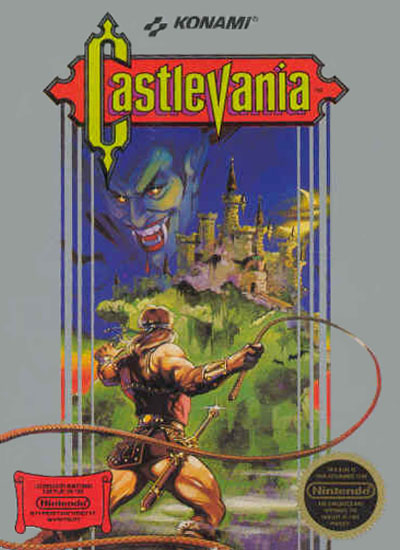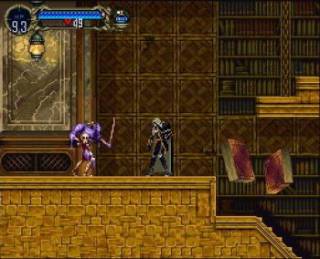Overview
 Castlevania Box Art (NES)
Castlevania Box Art (NES)Castlevania is a video games series developed and published by Konami. The series first debuted on September 26, 1986 in Japan, with the release of Demon Castle Dracula for the Nintendo Famicon. A different version of the game, Vampire Killer, was released for the MSX2 platform a month later. Castlevania had to wait for its North American release on the Nintendo Entertainment System in 1987 before it gathered any International recognition. The series soon became a recognized landmark in action platforming games and has since gathered a rather large cult following. The Castlevania series is highly regarded among gamers and has remained popular since its original release. While it was known in Japan as "Akumajo Dracula", or "Demon Castle Dracula", the English name "Castlevania" was not meant to mean anything, aside from suggesting the game's setting of a castle and being reminiscent of "Transylvania", the traditional home of Count Dracula. However, twenty-eight years after the release of the original game, the term came to mean something in-universe, when 2014's Castlevania: Lords of Shadow 2 put the player in a modern-day setting, a human metropolis built atop the ruins of Dracula's castle called "Castlevania City".
The early games in the Castlevania series borrowed material and influences from classic horror cinema. Later, the series was influenced heavily by Gothic fiction and dark romanticism, and the most recent Nintendo DS outing has adopted an anime-inspired art direction.
The Castlevania series is one of Konami's most famous and successful franchises, and various games has been released on the Nintendo Entertainment System, Super Nintendo, Nintendo 64, Sega Mega Drive, Sega Saturn, PC Engine, PlayStation, Playstation 2, Xbox, Nintendo DS, Game Boy, Game Boy Advance, PSP, MSX2, C64, Sharp X6800, and PC platforms.
Characters
The Belmont Family
The Belmont bloodline is sworn to oppose Dracula in all his various forms. In most Castlevania games, the main character is of Belmont decent; if not, the Belmonts are usually present in the form of supporting characters. The main weapon of choice for the Belmont family is the ancestral whip, named "Vampire Killer". It has been said that only members of the Belmont family can use the whip; anyone else will eventually die after using it.
Dracula
Dracula has been the main antagonist throughout the Castlevania series, though the portrayal of the character has varied over time. Dracula's full name is Dracula Vlad Tepes. He was originally depicted as a standard villain, but the character became much more dramatic as more titles were released. Dracula has always played an important role in the series; his legacy stays even in Castlevania: Aria of Sorrow, a game taking place after he was defeated and slain once and for all. In the games where Dracula is present, he often dresses the way the original Dracula was conceived: a black suit with a long cape.
Franchise History
The first outing of the Castlevania series, the original Castlevania for the NES, was a typical platform game in where the player controlled the game's protagonist Simon Belmont, a descendant of the Belmont Clan (see characters section). Simon ventures inside Castlevania, a vast demonic castle ruled by Count Dracula, where he fights supernatural beasts on his way to Dracula. He eventually makes his way through the castle interior to the top of the Castle, where the final boss fight traditionally is (most often, Dracula himself) in the Castlevania games. Belmont has to slay the evil Count Dracula using a family relic passed down generation to generation named the "Vampire Killer", which was blessed with the power to destroy vampires and other creatures of the night. Simon and the game's other heroes also possess secondary weapons, powered by hearts, which can be found by destroying candles (and enemies in later games).
A different version of the game, Vampire Killer, was released for the MSX2 computer platform a month later. This version introduced Metroidvania elements, allowing open-world exploration within a fortress environment, much like Metroid earlier that year.
The first sequel, Castlevania II: Simon's Quest, introduced several RPG elements, such as a non-linear world the player was free to explore and revisit, the ability to purchase supplies, equipment and weapon upgrades in various small towns, and (more importantly) a leveling up system.
The third game, Castlevania III: Dracula's Curse, returned to the traditional style and gameplay of the original game while updating it with new features such as alternate paths with new stages and multiple playable characters. It also introduced support characters, allies to fight alongside with the Belmonts together against Dracula and his evil minions.
 Castlevania: Symphony of the Night
Castlevania: Symphony of the NightThe biggest turning point for the series in terms of gameplay mechanics and physics was the release of Castlevania: Symphony of the Night. By using a wide-open world that the player was free to explore, similar to that seen previously in its predecessor Castlevania II as well as Super Metroid, Symphony of the Night popularized what is now commonly referred to as the "Metroidvania" style of gameplay, where the player is allowed to roam free in the game's environment but was only allowed access to a small number of areas at first. The rest of the game's areas are reached by doing certain tasks, such as completing a boss fight or finding objects and new abilities that let the player access new areas. This, combined with console RPG elements such as experience levels, hit points and magic points, usable items and the collection of new powers and abilities, weapons, armour and various items defines this style.
In addition to reinventing the technical aspects of Castlevania, Symphony of the Night adopted an entirely new art direction for the Castlevania world in which the games took place and the characters within them. With the joining of illustrator and concept artist Ayami Kojima onto the development team beginning with Symphony of the Night, the design underwent a total transformation into an elegant, beautiful appearance inspired by the European Baroque art periods (a style popular in Japan), effectively ending its previous Gothic horror theme. As such, the characters' dress and condition evolved into grand ensembles including flowing jackets and vests, and the imagery, landscape of the castle, and other game locations became lush and lavish.
The two Nintendo DS Castlevania games' art style reverted back to a more anime-inspired and simpler style similar to that of the original Dracula X: Rondo of Blood. Through this, Konami hoped to broaden the player demographic by persuading the (presumably slightly younger) DS gaming audience to not be put off by the otherwise mature image of Kojima's art.
The first games in the series made with 3D graphics were Castlevania (64) and Castlevania: Legacy of Darkness, both on the Nintendo 64. The reception they received was mixed at best, and sales were lackluster. These games are not as highly regarded by fans and are not often recognized or referred to positively. Symphony of the Night, as well as Dawn of Sorrow & Portrait of Ruin, both on the DS, also occasionally used 3D backgrounds.
Series creator and director Koji Igarashi has stated his interest in returning to the more traditional style of the earlier games in the series, but left Konami before he was able to implement this questionable decision.
In 2010, the series' increasingly complex timeline was wiped clean with a reboot for the Xbox 360 and PlayStation 3, Castlevania: Lords of Shadow, taking place in 1047 and depicting the quest of Gabriel Belmont, the first member of the family in this new universe. Lords of Shadow abandoned much of the framework of the previous games, and instead told Gabriel's story in the form of a character action game similar to God of War. Although the gameplay and storyline were critically praised, Lords of Shadow was criticized for its lack of traditional Castlevania elements, such as losing a large, explorable map in favour of a series of linear levels that players can replay with new items in order to get to treasures that were previously out of reach. Additionally, some fans of the original storyline took offence with the controversial ending.
It was followed by the Nintendo 3DS title Castlevania: Lords of Shadow - Mirror of Fate in 2012, a much more traditional side-scrolling, map-exploring affair, and 2014's Castlevania: Lords of Shadow 2 for the PS3, 360, and PC. Although Lords of Shadow 2 is primarily a character action game like the original Lords of Shadow, it implemented many changes to make the gameplay more like the traditional games in the franchise, such as making the world consist of two large, fully explorable regions that the player could freely wander about in, although the storyline does prod the player along a single linear path. It was, however, criticized for the questionable inclusion of stealth sequences that were generally regarded as unnecessary and somewhat frustrating.
It was officially stated that Lords of Shadow 2 would be the final game in the reboot series, though it currently remains to be seen whether the franchise will go back to the overcomplicated original storyline, start over a second time with another reboot, or even whether that was a simple marketing lie and the next game will still take place in the Lords of Shadow universe.
Original Chronology
When Koji Igarashi took over as producer for the series, he revised the timeline and removed Castlevania Legends, Castlevania (64), Castlevania: Legacy of Darkness, and Castlevania: Circle of the Moon. Reasons for these changes have never been clearly stated.
With the release of Castlevania: Portrait of Ruin however, Konami of America included a pre-order bonus "20th Anniversary" package that included a Castlevania series timeline. This timeline re-added all the games previously omitted besides Castlevania Legends. This timeline was altered once again the following year on the official Japanese Castlevania series website. This is the most current official timeline, and is what is listed below. Castlevania: Order of Ecclesia was not out when the timeline was made, but has since been retroactively added by the community.
Log in to comment